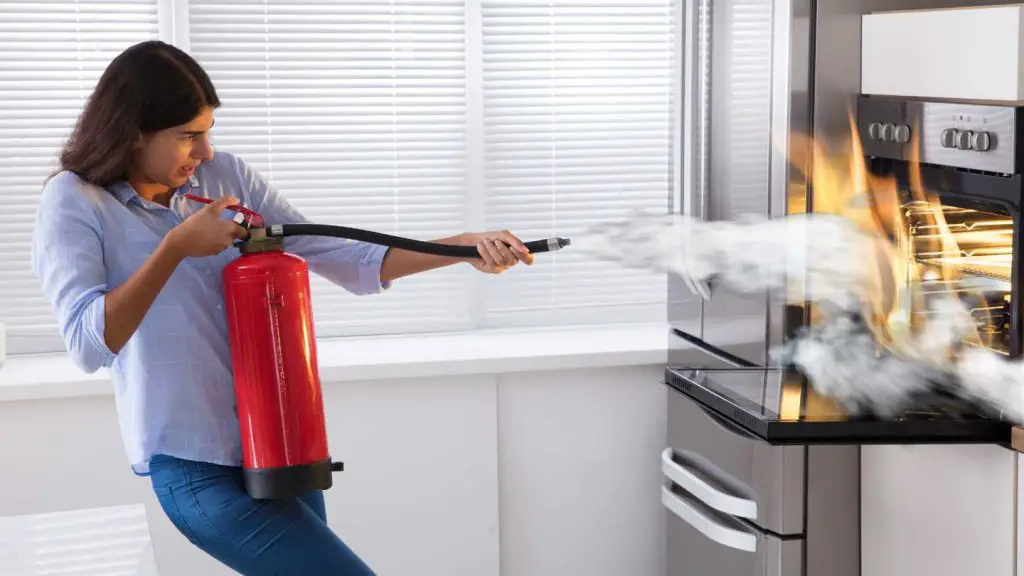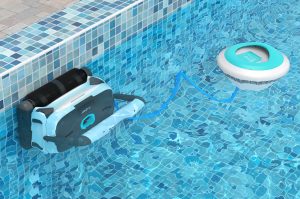Fire extinguishers are one of the most effective tools for preventing and controlling fires in the home. However, in order to use them properly, it is important to understand and interpret the symbols that are found in them. Here, we will discuss what these symbols mean and how they can be used effectively, so that the next time you see them, you will be able to know what each symbol is for. Let’s go!
The Different Types of Fire Extinguishers
Before delving into the significance of fire extinguisher symbols, it is important to have an understanding of the different types of fire extinguishers available in the market. There are five main types:
- Class A: Suitable for fires involving combustible materials such as paper, wood, or textiles.
- Class B: Suitable for fires involving flammable liquids like petrol or diesel.
- Class C: Suitable for fires involving electrical equipment.
- Class D: Suitable for putting out highly combustible metals such as magnesium or titanium.
- Class K: Used specifically for kitchen fires which may involve cooking oils and fats.
The majority of fire extinguishers carry more than one class rating to enable their use across multiple scenarios.
Understanding Fire Extinguisher Symbols
Fire extinguishers come with various markings designed to indicate their suitability against specific type(s) or class(es) of fire hazard(s). These markings include letters, pictograms (symbols), colors, and numbers; each with its own meaning which should not be overlooked when choosing your firefighting gear.
Classes

One key piece of information you will find displayed prominently on any modern-day fire-extinguishing device relates directly to its ability to tackle certain classes/types of fire risk factors – indicated by lettering from A through K (as mentioned earlier).
Each symbol indicates that particular type/class/group/size/etc., so if you see “A” inside a triangle on your device then it’s rated suitable only for combating fires involving ordinary combustibles like wood, paper, or cloth. The letter ‘B’ inside a square-shaped pictogram tells you that it’s intended for flammable liquids – oil, gasoline, etc.
Colors
The colors of fire extinguisher symbols are also important to take note of because they can help indicate the contents and capabilities of the extinguisher.
- Red: This is the most common color used on fire extinguishers and is typically associated with Class A fires.
- Blue: Used for electrical equipment fires.
- Green: Indicates suitability against burning organic (Class A) materials such as leaves, grass, or twigs.
- Yellow: Suitable for Class B/C type hazards – usually flammable gases/liquids as well as electrical items
- Black: Used on class D devices specifically aimed toward putting out metal-based blazes.
It should be noted that not all fire extinguishers have colored markings on them; some may only have letters or numbers displayed prominently instead.
Pictograms

Pictograms on a fire extinguisher are visual indicators present within an image that convey specific information about the device’s usage capabilities in emergencies quickly without having to rely solely upon text explanations. These graphics represent different types/classifications of firefighting agents contained within their respective cylinders/tanks.
Some commonly seen pictograms include:
- The green-colored letter “A”: Represents suitability for combatting Ordinary Combustibles.
- The red-colored letter “B”: Indicates suitable use against Flammable Liquids and gases.
- The blue-colored letter containing “C”: Means safe enough to put out Electrical Fires.
- The yellow-colored letter consisting of “D”: For handling highly-combustible/flammable metal fires safely.
- The black-colored square featuring “K”: Specifically designed for kitchen/cooking-related emergencies where there may be hot oils/fats involved.
These symbols are universal across devices made by various manufacturers globally – ensuring standardization is maintained wherever in the world you happen to find yourself needing to use one.
Numbers

The numbers on a fire extinguisher indicate the capacity of the firefighting agent contained within it. This number will typically be displayed as something like “4 A: 80B: C”. The “A” represents Agents for Class A fires, while “B” stands for flammable liquid fighting agents, and “C” refers to electrical fire suppression capabilities – with each figure indicating that a particular device can handle larger-sized blazes than those of lower numerical values.
How to Read a Fire Extinguisher Symbol
Now that we have covered what the symbols on fire extinguishers indicate, let’s dive deeper into how to read them.
Firstly, it is important to locate and identify the symbol. The most common location for these symbols is on the front of the device itself or on an accompanying label attached nearby. Once you have located it, examine each element of the symbol closely to interpret its meaning.
Classes
The first step in reading fire extinguisher symbols involves identifying which class(es) of fires your chosen device can handle. Sometimes this information may be displayed as lettering within geometric shapes like triangles (for Class A), squares (Class B), circles (Class C) Hexagons (class D), or pentagons(Class K).
For instance: if you see a pictogram shaped like a triangle with ‘A’ inside then this identifies suitability towards combating Ordinary Combustibles whereas one featuring “B” within an enclosed square denotes effectiveness against Flammable Liquids – all other combinations are self-explanatory and should be interpreted accordingly!
Colors
Next up, take note of any colors present on your chosen device – particularly when dealing with larger premises containing multiple units installed across various locations. Depending upon where you happen to find yourself during such emergencies may mean only certain types of devices are easily accessible – knowing color coding conventions could make all difference in getting everyone out safe & sound.
Pictograms
Another essential aspect when trying to decipher fire-extinguishing gear’s markings includes interpreting associated graphics/pictograms found alongside its lettering/number displays. They provide quick visual references that convey specific info about usage capabilities/features quickly without needing users’ access to textual explanations.
Make sure to identify which one(s) applies to your chosen device and make a note of it/them.
Numbers
Finally, take note of any numbers displayed on the fire extinguisher symbol. These indicate the capacity of the unit’s firefighting agent and are usually in the format like “2A:10B: C”. The first number represents agents suitable against Class A fires; the second figure stands for Flammable Liquid fighting agents while the last shows Electrical Fire Suppression capabilities.
It is worth noting that some devices may only display symbols without any accompanying numerical figures – making them less precise when trying to determine an exact weight/capacity at play.
how to Put Out a Small Fire Using a Fire Extinguisher
Knowing how to use a fire extinguisher to put out a fire can be the difference between life and death in an emergency. Here are some steps to take when putting out a small fire using this device.
Step 1: Assess the Situation
When encountering any fire in the home, it is important to assess the situation before attempting to put it out with an extinguisher. If the flames are too big or if you do not feel safe trying to put them out yourself – evacuate immediately and call for professional help instead.
If you decide that you can safely tackle the fire on your own, make sure that everyone else around is aware of what’s happening and has evacuated as necessary so no one’s safety is compromised during attempts at firefighting.
Step 2: Selecting The Correct Type of Extinguisher
Next up – ensure selecting the right type/classification of devices from among various available options depending upon the nature/size of fires encountered within your home environments (as discussed earlier).
For instance, Class A-rated units should only be used against ordinary combustibles like wood or paper-based fires; whereas those rated ‘B’ would work well against flammable liquids such as petrol or diesel-based blazes which may occur in garages/workshops, etc., electrical equipment should only be tackled via the usage of devices marked “C” specifically designed for handling electronic hazards safely.
Step 3: Aim at the Base Of the Flames From a Safe Distance
Once you have selected the appropriate fire extinguisher based on the considerations mentioned above, approach flames from a sufficient distance & aim the nozzle/hose at its base (not top) while squeezing the handle/pulling pin simultaneously until contents begin flowing towards the target area – but avoid getting too close because the heat generated by the blaze could cause injury!
It’s better to stay back initially and then gradually move closer until you finally reach the point of interest without endangering yourself/others involved nearby.
Also worth noting here – try to avoid spraying all contents in one go since it may not be sufficient to put out larger fires – instead, use short bursts directed towards the base of the flames until they start dying down & are eventually extinguished.
Step 4: Evacuate
Finally, once you have managed to successfully put out the fire using a fire extinguisher – make sure the area remains safe before leaving completely because there might be potential for re-ignition. Keep an eye on the surroundings to see if it contains any residual hotspots that need tending to so nothing flares up again unexpectedly and endangers anyone nearby.
Also if at any time during the attempts to put out a fire, it seems beyond control then don’t hesitate to evacuate the vicinity immediately without delay and call for professional help.
How Many Fire Extinguishers Do You Need For Your Home?
The number of fire extinguishers required for your home depends on various factors such as the size of your home, presence/extent of fire-prone areas (e.g., kitchen), proximity-to-nearest-emergency-service station, etc. As a general guideline, we recommended a minimum of two fire extinguishers installed per household which should be typically placed within quick-accessible locations like kitchens/living spaces /walkways, etc.
It is essential when purchasing these units though to ensure their suitability towards handling likely hazards present within your home by taking time to select appropriate types/classes based upon your needs and requirements.
What Type of Fire Extinguisher is Used for Electrical Fires?
The best type of fire extinguisher for use on an electrical fire is known as a Class C extinguisher. This type uses non-conductive agents to put out the flames without conducting electricity back into the user’s body while fighting the blaze.
When dealing with electrical fires – traditional firefighting methods can actually exacerbate issues rather than solve them due to the conductivity aspects involved. This means using only type-C-rated equipment specifically designed to combat electronic-related emergencies safely should always be used where possible.
These units usually contain non-conductive agents like carbon dioxide or dry powder which work well against electrical blazes without causing further damage/injury risk to users/devices nearby! So, If you encounter. kitchen appliances like refrigerators or ovens going aflame, your best bet would be to use a class C fire extinguisher for them.
conclusion
Fire extinguishers are an essential tool in preventing and controlling fires. Understanding their symbols is critical when choosing which type of fire-extinguishing gear you need in any given situation. Although there may seem to be many different types of ratings, codes, and classifications – understanding them all is crucial if you want to make sure everyone stays safe from harm during emergencies involving flames or smoke!
Reading fire-extinguishing gear’s markings isn’t just about identifying what each element means – but also learning how best to use these devices under different situations as well as understanding standardized conventions globally used across various manufacturers’ products.
If you took the time to read up to this point you should definitely be a pro in deciphering the symbols on a fire extinguisher and how to use them. Congratulations dear pro home fireman! You earned it!






